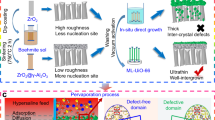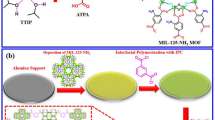Abstract
The rational design of high-performance desalination membranes is critical to enable sustainable water treatment applications. However, conventional polymeric membranes suffer from insufficient stability especially under harsh chemical conditions. Here we show a novel robust ceramic-based UiO-66 metal–organic framework nanoporous membrane molecularly engineered with missing linkers, enabling more challenging chemically harsh desalination applications. The membranes show competitive desalination performance, which is higher than most state-of-the-art asymmetric and thin-film composite polymeric osmotic membranes. Experimental and molecular simulation results indicate that introducing missing-linker defects substantially increases water flux, allowing faster transport of water clusters with a lower energy barrier via enlarging the pore size of metal–organic framework nanochannels. Notably, the UiO-66 membranes exhibit exceptional stability compared with polymeric membranes under high oxidizing (chlorine) and alkaline conditions and promising application potential in industrial wastewater treatment. Our work provides a new rational design of robust high-performance desalination membranes for expanded water treatment applications that are not feasible by conventional polymeric membranes.
This is a preview of subscription content, access via your institution
Access options
Subscribe to this journal
Receive 12 digital issues and online access to articles
$99.00 per year
only $8.25 per issue
Buy this article
- Purchase on Springer Link
- Instant access to full article PDF
Prices may be subject to local taxes which are calculated during checkout






Similar content being viewed by others
Data availability
All data are available from the corresponding authors upon reasonable request. Source data are provided with this paper.
Code availability
All simulation codes are available from the corresponding authors upon reasonable request.
References
Shannon, M. A. et al. Science and technology for water purification in the coming decades. Nature 452, 301–310 (2008).
Montgomery, M. A. & Elimelech, M. Water and sanitation in developing countries: including health in the equation. Environ. Sci. Technol. 41, 17–24 (2007).
Werber, J. R., Osuji, C. O. & Elimelech, M. Materials for next-generation desalination and water purification membranes. Nat. Rev. Mater. 1, 16018 (2016).
Lee, K. P., Arnot, T. C. & Mattia, D. A review of reverse osmosis membrane materials for desalination—development to date and future potential. J. Membr. Sci. 370, 1–22 (2011).
Yang, H.-C., Luo, J., Lv, Y., Shen, P. & Xu, Z.-K. Surface engineering of polymer membranes via mussel-inspired chemistry. J. Membr. Sci. 483, 42–59 (2015).
Wang, J. et al. Fast polydopamine coating on reverse osmosis membrane: process investigation and membrane performance study. J. Colloid Interface Sci. 535, 239–244 (2019).
Tharayil, J. M., Manaf, A. & Johnson, N. J. Sustainable forward osmosis desalination: a review on polymeric membranes and flux parameters. Int. J. Environ. Anal. Chem. https://doi.org/10.1080/03067319.2020.1784414 (2020).
Goda, S. & Sekino, M. Application of irreversible thermodynamic model to a hollow fiber forward osmosis module in sodium chloride aqueous solution system. Desalination 486, 114458 (2020).
Khazaie, F., Sheshmani, S., Shokrollahzadeh, S. & Shahvelayati, A. S. Desalination of saline water via forward osmosis using magnetic nanoparticles covalently functionalized with citrate ions as osmotic agent. Environ. Technol. 43, 2113–2123 (2020).
Zhang, M. et al. Engineering a nanocomposite interlayer for a novel ceramic-based forward osmosis membrane with enhanced performance. Environ. Sci. Technol. 54, 7715–7724 (2020).
Wang, Y.-N., Goh, K., Li, X., Setiawan, L. & Wang, R. Membranes and processes for forward osmosis-based desalination: recent advances and future prospects. Desalination 434, 81–99 (2018).
Morales-Torres, S., Esteves, C. M. P., Figueiredo, J. L. & Silva, A. M. T. Thin-film composite forward osmosis membranes based on polysulfone supports blended with nanostructured carbon materials. J. Membr. Sci. 520, 326–336 (2016).
Gray, G. T., McCutcheon, J. R. & Elimelech, M. Internal concentration polarization in forward osmosis: role of membrane orientation. Desalination 197, 1–8 (2006).
Assaad, N., Sabeh, G. & Hmadeh, M. Defect control in Zr-based metal–organic framework nanoparticles for arsenic removal from water. ACS Appl. Nano Mater. 3, 8997–9008 (2020).
Tang, A. et al. Engineering novel thin-film composite membranes with crater-like surface morphology using rigidly-contorted monomer for high flux nanofiltration. Desalination 509, 115067 (2021).
Yao, Y. et al. High performance polyester reverse osmosis desalination membrane with chlorine resistance. Nat. Sustain. 4, 138–146 (2021).
Valenzano, L. et al. Disclosing the complex structure of UiO-66 metal organic framework: a synergic combination of experiment and theory. Chem. Mater. 23, 1700–1718 (2011).
Bai, Y. et al. Zr-based metal–organic frameworks: design, synthesis, structure, and applications. Chem. Soc. Rev. 45, 2327–2367 (2016).
Li, W. Metal–organic framework membranes: production, modification, and applications. Prog. Mater Sci. 100, 21–63 (2019).
Kadhom, M. & Deng, B. Metal–organic frameworks (MOFs) in water filtration membranes for desalination and other applications. Appl. Mater. Today 11, 219–230 (2018).
Liu, X., Demir, N. K., Wu, Z. & Li, K. Highly water-stable zirconium metal–organic framework UiO-66 membranes supported on alumina hollow fibers for desalination. J. Am. Chem. Soc. 137, 6999–7002 (2015).
Lu, J. et al. Ultrafast rectifying counter-directional transport of proton and metal ions in metal–organic framework-based nanochannels. Sci. Adv. 8, eabl5070 (2022).
Lu, J. et al. Efficient metal ion sieving in rectifying subnanochannels enabled by metal–organic frameworks. Nat. Mater. 19, 767–774 (2020).
Wang, X. et al. Robust ultrathin nanoporous MOF membrane with intra-crystalline defects for fast water transport. Nat. Commun. 13, 266 (2022).
Dong, Y. et al. Stable superhydrophobic ceramic-based carbon nanotube composite desalination membranes. Nano Lett. 58, 5514–5521 (2018).
Cliffe, M. J. et al. Correlated defect nanoregions in a metal–organic framework. Nat. Commun. 5, 4176 (2014).
Feng, Y., Chen, Q., Jiang, M. & Yao, J. Tailoring the properties of UiO-66 through defect engineering: a review. Ind. Eng. Chem. Res. 58, 17646–17659 (2019).
Winarta, J. et al. A decade of UiO-66 research: a historic review of dynamic structure, synthesis mechanisms, and characterization techniques of an archetypal metal–organic framework. Cryst. Growth Des. 20, 1347–1362 (2019).
Song, L., Heiranian, M. & Elimelech, M. True driving force and characteristics of water transport in osmotic membranes. Desalination 520, 115360 (2021).
Beshkar, F., Salavati-Niasari, M. & Amiri, O. A reliable hydrophobic/superoleophilic fabric filter for oil–water separation: hierarchical bismuth/purified terephthalic acid nanocomposite. Cellulose 27, 9559–9575 (2020).
Alihemati, Z., Hashemifard, S. A., Matsuura, T., Ismail, A. F. & Hilal, N. Current status and challenges of fabricating thin film composite forward osmosis membrane: a comprehensive roadmap. Desalination 491, 114557 (2020).
Tang, C. Y., She, Q., Lay, W. C. L., Wang, R. & Fane, A. G. Coupled effects of internal concentration polarization and fouling on flux behavior of forward osmosis membranes during humic acid filtration. J. Membr. Sci. 354, 123–133 (2010).
Mahpoz, N. M. et al. ZIF-8 membrane supported on alumina hollow fiber with enhanced salt removal by forward osmosis. Desalination 496, 114697 (2020).
You, S.-J. et al. Temperature as a factor affecting transmembrane water flux in forward osmosis: steady-state modeling and experimental validation. Chem. Eng. J. 198-199, 52–60 (2012).
Phuntsho, S. et al. Influence of temperature and temperature difference in the performance of forward osmosis desalination process. J. Membr. Sci. 415-416, 734–744 (2012).
Wang, Q., Zhou, Z., Li, J., Tang, Q. & Hu, Y. Modeling and measurement of temperature and draw solution concentration induced water flux increment efficiencies in the forward osmosis membrane process. Desalination 452, 75–86 (2019).
Lyu, Q., Deng, X., Hu, S., Lin, L.-C. & Ho, W. S. W. Exploring the potential of defective UiO-66 as reverse osmosis membranes for desalination. J. Phys. Chem. C 123, 16118–16126 (2019).
Liu, L. et al. Imaging defects and their evolution in a metal–organic framework at sub-unit-cell resolution. Nat. Chem. 11, 622–628 (2019).
Heiranian, M., Fan, H., Wang, L., Lu, X. & Elimelech, M. Mechanisms and models for water transport in reverse osmosis membranes: history, critical assessment, and recent developments. Chem. Soc. Rev. 52, 8455–8480 (2023).
Wang, L. et al. Water transport in reverse osmosis membranes is governed by pore flow, not a solution-diffusion mechanism. Sci. Adv. 9, eadf8488 (2023).
Shearer, G. C. et al. Tuned to perfection: ironing out the defects in metal–organic framework UiO-66. Chem. Mater. 26, 4068–4071 (2014).
Wang, Y. H. et al. Chlorine disinfection significantly aggravated the biofouling of reverse osmosis membrane used for municipal wastewater reclamation. Water Res. 154, 246–257 (2019).
Gong, W. et al. Topological strain-induced regioselective linker elimination in a chiral Zr(IV)-based metal-organic framework. Chem 7, 190–201 (2021).
Nguyen, H. L. Metal–organic frameworks can photocatalytically split water-why not? Adv. Mater. 34, 2200465 (2022).
Howarth, A. J. et al. Chemical, thermal and mechanical stabilities of metal–organic frameworks. Nat. Rev. Mater. 1, 15018 (2016).
Cavka, J. H. et al. A new zirconium inorganic building brick forming metal organic frameworks with exceptional stability. J. Am. Chem. Soc. 130, 13850–13851 (2008).
Yuan, B. et al. Cross-linked graphene oxide framework membranes with robust nano-channels for enhanced sieving ability. Environ. Sci. Technol. 54, 15442–15453 (2020).
Si, Y. et al. Flexible superhydrophobic metal-based carbon nanotube membrane for electrochemically enhanced water treatment. Environ. Sci. Technol. 54, 9074–9082 (2020).
Wang, X. et al. Improving water-treatment performance of zirconium metal–organic framework membranes by postsynthetic defect healing. ACS Appl. Mater. Interfaces 9, 37848–37855 (2017).
Wu, W., Li, Z., Chen, Y. & Li, W. Polydopamine-modified metal–organic framework membrane with enhanced selectivity for carbon capture. Environ. Sci. Technol. 53, 3764–3772 (2019).
Zhang, K. et al. Exploration of food preservatives as draw solutes in the forward osmosis process for juice concentration. J. Membr. Sci. 635, 119495 (2021).
Acknowledgements
This work was financially supported by the National Natural Science Foundation of China (NSFC)-Research Grants Council (RGC) Joint Program (number 52261160381, Y.D.) and NSFC General Program (number 52070033, Y.D.). The work is also partially supported by the NSFC-RGC Joint Research Scheme (project number N_HKU721/22, C.T.) from the Research Grants Council of the Hong Kong Special Administration Region, China. We also would like to express our sincere appreciations to USTC, DUT and CUHK for support.
Author information
Authors and Affiliations
Contributions
H.-Q.Y., M.E. and Y.D. supervised this project. Y.D. made the idea and contributions. Q.L. and L.-C.L. performed the computational simulations. Y.H. performed the low-dose TEM experiments. Y.D. wrote the manuscript. M.E., H.-Q.Y. and Y.D. revised the manuscript. Q.L., C.V., C.T. and B.L. made some important contributions to this work. All authors approved the manuscript.
Corresponding authors
Ethics declarations
Competing interests
The authors declare no competing interests.
Peer review
Peer review information
Nature Water thanks Yan Zhao and the other, anonymous, reviewer(s) for their contribution to the peer review of this work.
Additional information
Publisher’s note Springer Nature remains neutral with regard to jurisdictional claims in published maps and institutional affiliations.
Supplementary information
Supplementary Information
Supplementary Figs. 1–17 and Tables 1–6.
Source data
Source Data Fig. 1
Statistical source data.
Source Data Fig. 2
Statistical source data.
Source Data Fig. 3
Statistical source data.
Source Data Fig. 4
Statistical source data.
Source Data Fig. 5
Statistical source data.
Source Data Fig. 6
Statistical source data.
Rights and permissions
Springer Nature or its licensor (e.g. a society or other partner) holds exclusive rights to this article under a publishing agreement with the author(s) or other rightsholder(s); author self-archiving of the accepted manuscript version of this article is solely governed by the terms of such publishing agreement and applicable law.
About this article
Cite this article
Dong, Y., Lyu, Q., Lin, LC. et al. Ultrastable ceramic-based metal–organic framework membranes with missing linkers for robust desalination. Nat Water (2024). https://doi.org/10.1038/s44221-024-00218-5
Received:
Accepted:
Published:
DOI: https://doi.org/10.1038/s44221-024-00218-5



